Some of the rarest types of bats are white. Bats can be partly white or fully white and can be found around the world.
From the depths of The Grand Canyon to the Amazon rainforest, these types of bats are found in The Americas, Asia, and Australia.
Some species of white bats are rare while others live in high numbers across the rainforest.
Often perceived as rare due to living in some of the most remote areas of the world, white bats can also fly above the tree line at night, which makes them a very rare sight.
The following species of white bats are representative of different and sometimes remote regions of the world. Here’s what makes them unique
Table of Contents
1. Canyon Bat
Canyon Bats (Parastrellus hesperus) are white bats native to The Western US and Western Mexico territories.
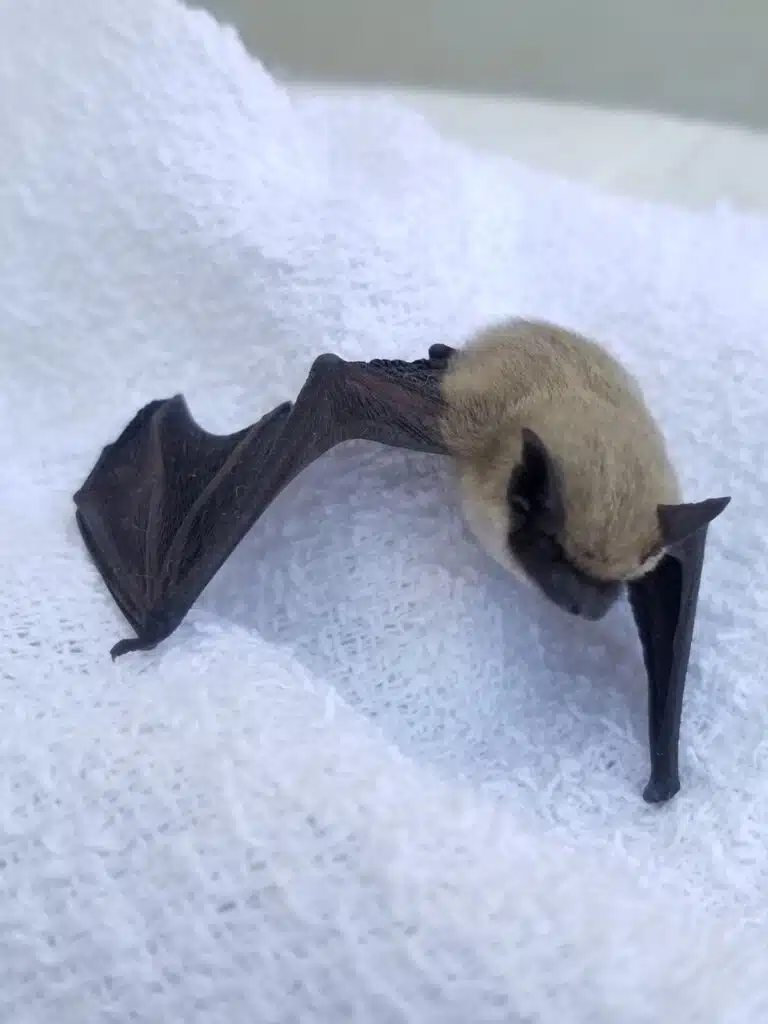
A bright appearance is specific to the body of this bat. Mostly white or off-white, this is a species that’s bright over its hairy sections.
A dark brown face contrasts its mostly white appearance, together with the brown wings and legs.
This species may be spotted at the beginning of the summer when they breed. 1-2 offspring are specific per female.
While active throughout the year, Canyong Bats may enter hibernation when the weather is too cold.
Not all bats of the species retreat into hibernation but those that do, typically decide to do it on their own.
Considerably more solitary than other bats, Canyon Bats are mostly seen on their own, except during the breeding period.
These bats also enter and exit hibernation on their own. Unlike truly hibernating bats, they can exit hibernation to eat and enter hibernation again.
2. Honduran White Bat
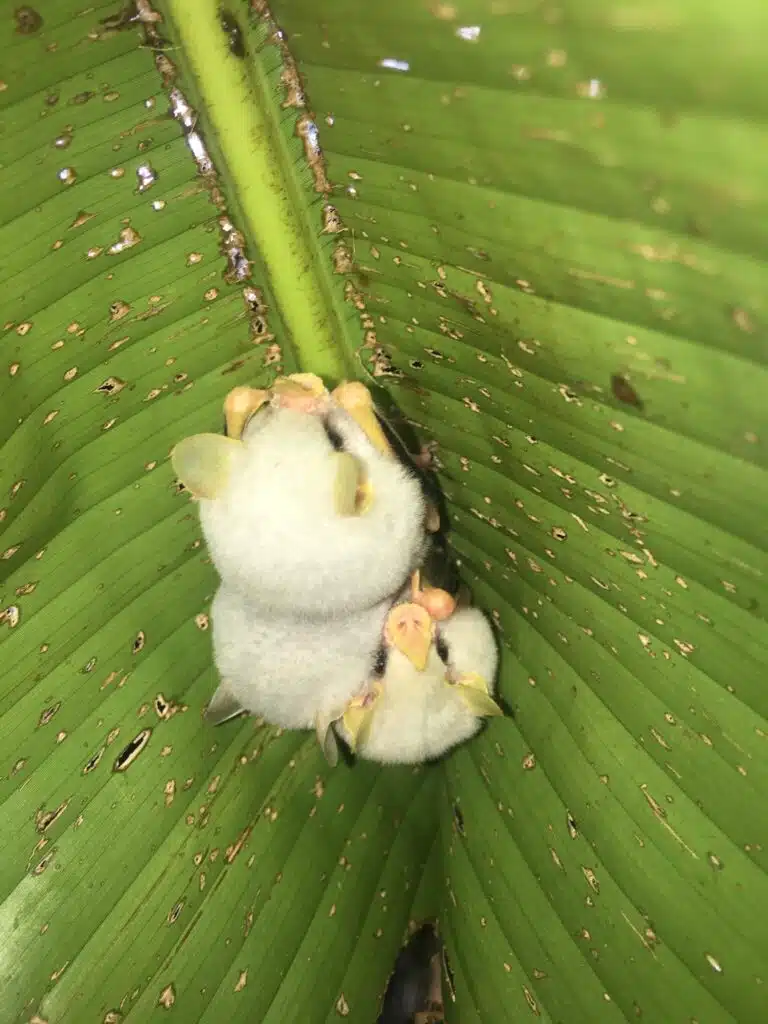
The mostly white coloring is specific to The Honduran White Bat (Ectophylla alba).
This fuzzy-looking bat has a yellow nose and elongated yellow years which are the result of carotenoid pigmentation.
Mostly white, The Honduran White Bat is almost extinct. It lives in Honduras, Panama, Costa Rica, and Nicaragua, preferably in dense forests.
This type of bat is further known for making the most of its forested habitat by utilizing the leaves of its host trees as a tent-like shelter.
Large leaves are modified for them to bend and create a tent-like structure by these bats.
Female Honduran White Bats, also mostly white, are responsible for cutting the veins of the leaves, which prompts them to fall into a tent that acts as a shelter for these bats.
Both males and females are found here during the day as they avoid coming out for food in the warmest periods at noon.
Honduran White Bats are mostly frugivores, eating the fruit of only specific figs.
A colony of these bats can number hundreds of individuals. While separated into groups in tent-like leave shelters, these bats live within the same area.
Their communal living even expands into breeding patterns as all females of a given colony give birth at the same time, in just several days.
3. Northern Ghost Bat
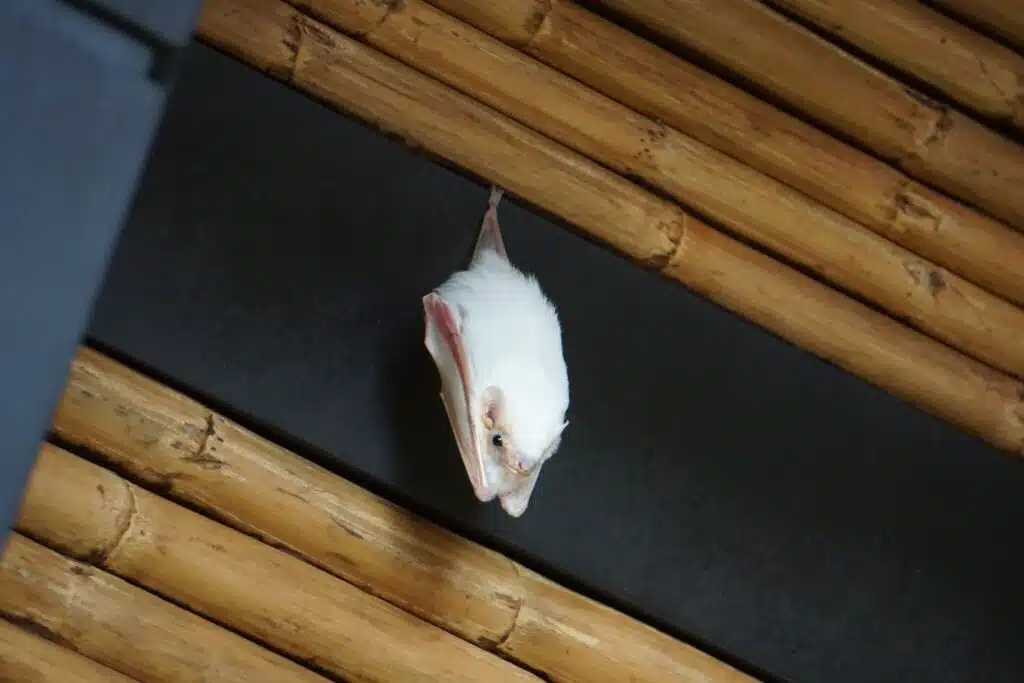
Also a nocturnal species, Northern Ghost Bats (Diclidurus albus) are mostly white.
Their underside is completely white while the face is pink-red. There’s also an atypical type of sac these bats feature.
Native to Southern Central America and South America, Northern Ghost Bats inhabit forests, caves, and open fields.
Most bats of the species prefer to live among palms and rest under palm trees during the day.
An insectivorous species, the bat only comes out for food at night.
Not much is known about the lifespan of these bats but there’s evidence to show they live highly solitary lives.
This species moves out onto a different area of the forest and different palm trees as an adult.
A sole exception applies in the breeding season when the bat is seen in pairs.
Also found in caves and abandoned mines, this species may be found in small scattered groups, but these scattered groups are still smaller than those of other bats.
The species may only be spotted on palm trees or in old mines as they only come out at night. Even when they start looking for food, these bats fly too high to be easily noticed.
4. Lesser Ghost Bat
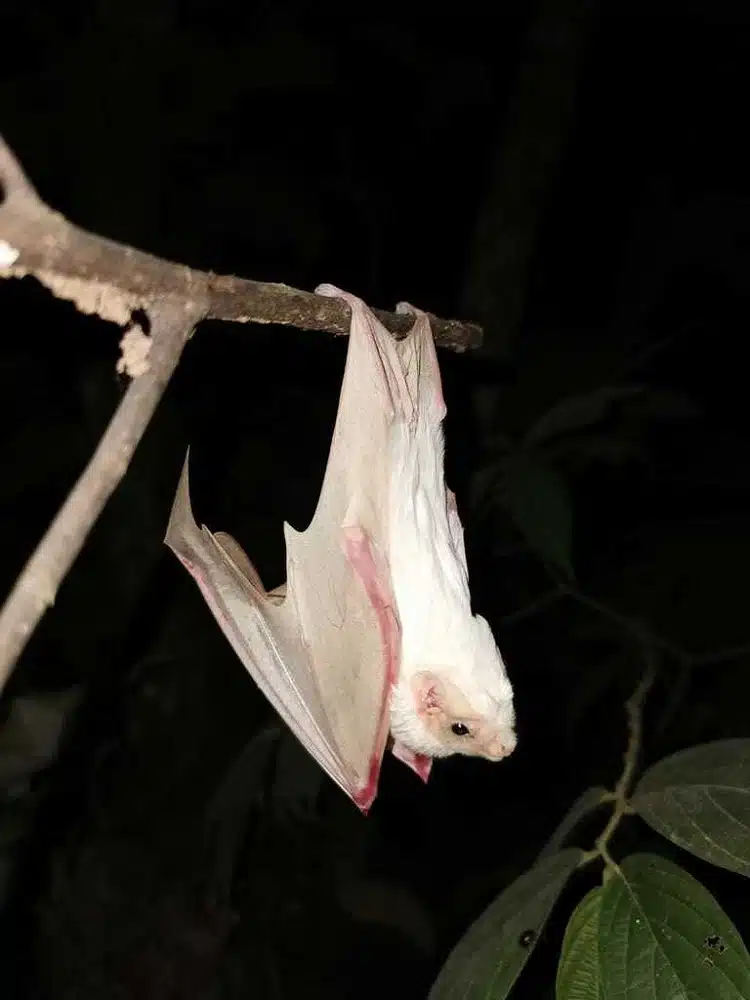
Lesser Ghost Bats (Diclidurus scutatus) are also primarily white. This is a species with a white hairy body and a gray face.
Much of its habits are similar to those of Honduran White Bats. Both species take shelter in the leaves of palm trees.
These types of bats do this by partly eating the large leaves of palms which then causes them to bend and to create a tent-like structure for them to live in.
Unlike the Honduran White Bat, The Lesser Ghost Bat is a species that lives across the Northern part of South America and not in Central America.
This is a species with a strong presence in Guyana, Ecuador, Suriname, Colombia, and Brazil.
As with many other bats, this is also a species that seems elusive. Its nocturnal habits and forest living make it a rare sight.
Largely elusive, these types of bats forage above the trees or for insects above water. Spotting them is a rare sight compared to almost all other bats in the area.
5. Greater Ghost Bat
The Greater Ghost Bat (Diclidurus ingens) is another common South American native of a white nuance.
All-white coloring is characteristic of this bat. Its face is mostly pink, as are its wings.
Found in the forests of Northern South America, this is a species with a strong presence in The Guyanas, Colombia, Venezuela, and Peru.
Largely unknown to the scientific world in terms of breeding habits, this is an elusive species that’s difficult to catch and study.
It flies high, at or above tree level which makes it one of the bats that are also almost impossible to spot, particularly as they fly at night, despite their white color.
One time when they can be spotted is when resting during the day. These bats live in small groups or on their own under palm leaves.
They hide under palm leaves so that no predator spots them where they remain for a long time, only coming out for foods such as insects at night.
6. Isabelle’s Ghost Bat
Mostly white and partly brown, Isabelle’s Ghost Bat (Diclidurus isabella) is endemic to Northern South America.
Also elusive to the scientific community, this is a type of mostly white bat with some bright brown areas.
The white nuance of the species may sometimes lead to confusion with other species in Brazil and Venezuela where white bats live under tree leaves.
According to some reports, this is also a species that lives in Colombia either permanently or moving in for food.
This bat can be distinguished from others by its bright grey inner ears and by its sharp long front teeth.
Dark brown wings are specific to the species while its eyes are fully black.
Isabelle’s Ghost Bats are solitary, rarely mixing with other bats or even with bats of their species.
The beginning of the summer marks the period when they can be seen together under palm leaves.
Capturing and studying this type of bat is difficult due to its high-flying patterns.
Researchers use mist nets to capture bats, in general. Isabelle’s Ghost Bats fly above these mist nests, basically becoming one of the multiple elusive types of white bats.
Bats of this species are believed to be named after the creamy color referred to as isabelline in the animal world.
7. Cuban Flower Bat
One of the atypical types of white bats in the world is The Cuban Flower Bat (Phyllonycteris poeyi).
This species has a white or gray-white appearance with dark wings and is only found around Cuba.
As its name implies, it’s one of the bats that feeds on plant pollen, mainly at night. On occasion, these bats may also resort to more typical dietary options such as insects.
Cuban Flower Bats aren’t very good at flying or even hovering around plants, which may lead to their capture easier than those of other white bats.
This is also a species that flies low for pollen, unlike white bats that fly above the canopy.
Still a nocturnal species, the bat retreats to caves and dark crevices for the day.
Unlike many other types of white bats, it does this in groups. It also comes out for food at night in groups.
A typical Cuban Flower Bat group numbers up to tens of individuals coming out for food at night.
Even more, these bats have no problem mixing with other bats in Cuba, often sharing the same location at night.
Interbreeding isn’t specifically known in this species but it’s believed larger and mixed groups of Cuban bats help the species in front of predators such as owls.
8. Ghost Bat
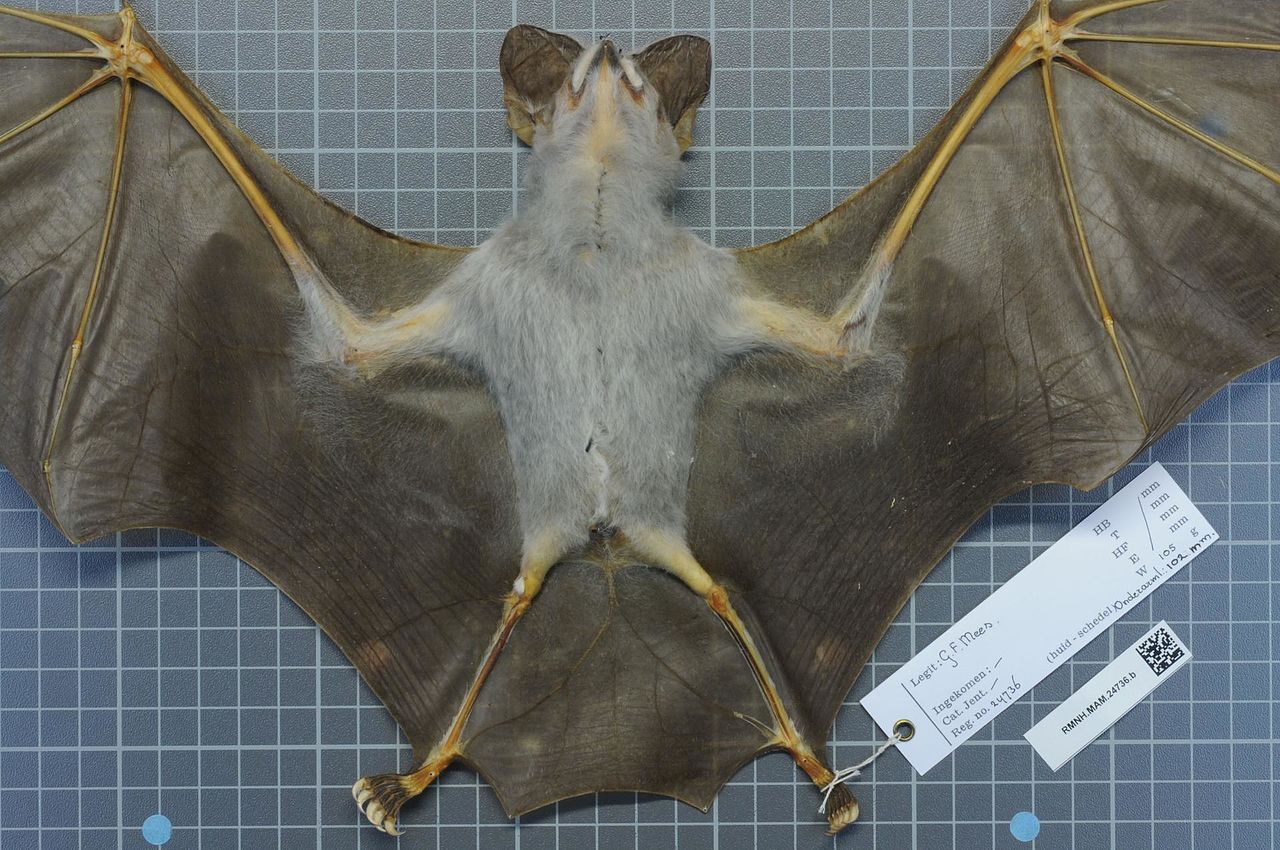
Ghost Bats (Macroderma gigas) are native to Australia and have either white or gray coloring.
This is one of the larger species of white bats and this allows it to capture prey other bats cannot.
Some of its atypical foods include birds and reptiles. A capable predator, this species uses echolocation and very good hearing to locate moving prey.
It often resorts to ambushing techniques where it simply waits for movement before flying out.
These bats also count on their vision to locate birds up on trees to hunt down.
Its entire body is used to capture large prey such as birds. Ghost Bats can wrestle birds down to the ground by wrapping their wings around them.
They also go for a quick kill by biting their necks first. Reptiles and frogs are also eaten by these bats.
Even small snakes are often prey to these bats that are widespread around Northern Australia.
9. Spotted Bat

Spotted Bats (Euderma maculatum) are some of the rarest types of white bats in North America and in the world.
Over the years, just a few of these bats were even captured, so almost nothing is known about their breeding behaviors and feeding behaviors.
By estimates, this is a bat that either feeds exclusively or mostly on moths.
Its appearance is striking as well. Its underside is mostly white while its back is black with black spots on the shoulders.
Living in some of the most remote crevices and even in The Grand Canyon, this species likes remote living around Western North America.
By some estimates, it’s also the bat with the largest ears on the continent, which helps it pick out both prey and potential predators quickly.
Often resting or waiting directly perched on cliffs and exposed rocks, these bats are almost impossible to interact with for humans and even for their predators.
Some photographers may still spot it in The Grand Canyon but its range is extensive along The Rocky Mountains.
10. Albino Bats
61 bat species are known to suffer from albinism. This is a rare melanin deficiency in vertebrates, but one that produces white bats.
White hairs and even white wings are possible with albino bats. There’s always a possibility of only having a small white area as well.
There are 4 types of albinism in bats which range from local or limited to widespread where the bat is completely white.
Albinism is inherited in bats, as in other species. Both parents need to be albinos to make albino offspring.
As in other species, albino bats can suffer from their melanin issue. For example, they become increasingly more vulnerable in front of predators such as owls.
Easier to spot, albino bats may not live as long as other bats that survive up to 10-20 years in the wilderness.
Other types of albino bats are also hunted by humans who find their white color interesting. They may even have white wings, which makes them completely different.
Among them, bats can also discriminate against albino bats which may be excluded from the group in the case of the bats that live in groups.